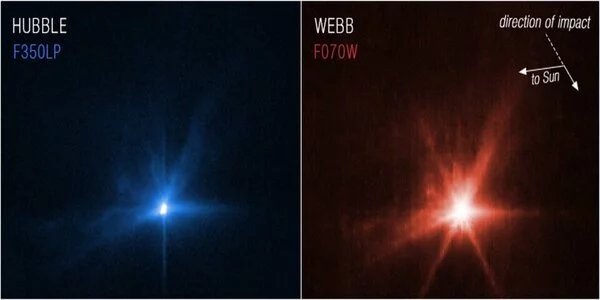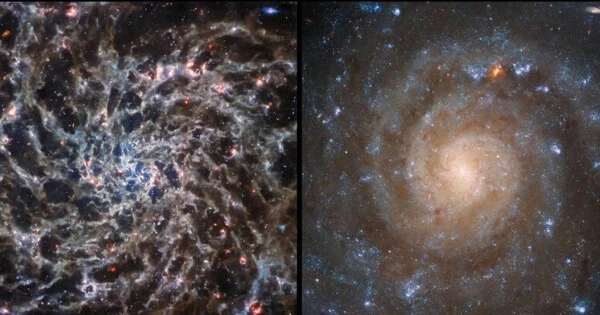The James Webb Space Telescope and the Hubble Space Telescope, two of NASA’s Great Observatories, have captured images of a unique NASA experiment designed to intentionally smash a spacecraft into a small asteroid in the world’s first-ever in-space test for planetary defense. These observations of NASA’s Double Asteroid Redirection Test (DART) impact are the first time Webb and Hubble have observed the same celestial target at the same time.
DART intentionally collided with Dimorphos, the asteroid moonlet in Didymos’ double-asteroid system, on September 26, 2022, at 7:14 p.m. EDT. It was the world’s first test of the kinetic impact mitigation technique, which involved using a spacecraft to deflect and alter the orbit of an asteroid that poses no threat to Earth. DART is a test for defending Earth against potential asteroid or comet hazards.
The coordinated Hubble and Webb observations are more than just an operational milestone for each telescope; there are also key science questions about the composition and history of our solar system that researchers can investigate by combining the capabilities of these observatories.
“Webb and Hubble demonstrate what we’ve always known at NASA: we learn more when we work together,” said NASA Administrator Bill Nelson. “For the first time, Webb and Hubble captured images from the same target in space: an asteroid that was impacted by a spacecraft after a seven-million-mile journey. All of humanity is looking forward to the discoveries made by Webb, Hubble, and our ground-based telescopes about the DART mission and beyond.”
Webb and Hubble demonstrate what we’ve always known at NASA: we learn more when we work together. For the first time, Webb and Hubble captured images from the same target in space: an asteroid that was impacted by a spacecraft after a seven-million-mile journey. All of humanity is looking forward to the discoveries made by Webb, Hubble, and our ground-based telescopes about the DART mission and beyond.
Bill Nelson
The observations from Webb and Hubble will allow scientists to learn more about the nature of Dimorphos’ surface, how much material was ejected by the collision, and how quickly it was ejected. Furthermore, Webb and Hubble captured the impact in different light wavelengths: Webb in infrared and Hubble in visible. Observing the impact at various wavelengths will reveal the distribution of particle sizes in the expanding dust cloud, assisting in determining whether it emitted a lot of large chunks or mostly fine dust. Combining this data with observations from ground-based telescopes will allow scientists to better understand how effectively a kinetic impact can alter an asteroid’s orbit.
Webb Captures Impact Site Before and After Collision
Webb took one observation of the impact location before the collision took place, then several observations over the next few hours. Images from Webb’s Near-Infrared Camera (NIRCam) show a tight, compact core, with plumes of material appearing as wisps streaming away from the center of where the impact took place.
Observing the impact with Webb presented the flight operations, planning, and science teams with unique challenges, because of the asteroid’s speed of travel across the sky. As DART approached its target, the teams performed additional work in the weeks leading up to the impact to enable and test a method of tracking asteroids moving over three times faster than the original speed limit set for Webb.

“I have nothing but tremendous admiration for the Webb Mission Operations folks that made this a reality,” said principal investigator Cristina Thomas of Northern Arizona University in Flagstaff, Arizona. “We have been planning these observations for years, then in detail for weeks, and I’m tremendously happy this has come to fruition.”
Scientists also plan to observe the asteroid system in the coming months using Webb’s Mid-Infrared Instrument (MIRI) and Webb’s Near-Infrared Spectrograph (NIRSpec). Spectroscopic data will provide researchers with insight into the asteroid’s chemical composition.
Webb observed the impact over five hours total and captured 10 images. The data was collected as part of Webb’s Cycle 1 Guaranteed Time Observation Program 1245 led by Heidi Hammel of the Association of Universities for Research in Astronomy (AURA).
Hubble Images Show Movement of Ejecta after Impact
Hubble also captured observations of the binary system ahead of the impact, then again 15 minutes after DART hit the surface of Dimorphos. Images from Hubble’s Wide Field Camera 3 show the impact in visible light. Ejecta from the impact appear as rays stretching out from the body of the asteroid. The bolder, fanned-out spike of ejecta to the left of the asteroid is in the general direction from which DART approached.
Some of the rays appear to be slightly curved, but astronomers must examine them more closely to determine what this could mean. Astronomers estimate that the brightness of the system increased threefold after impact, and that brightness remained constant even eight hours later, based on Hubble images.
Hubble intends to check in on the Didymos-Dimorphos system ten more times in the next three weeks. Regular, relatively long-term observations of the ejecta cloud as it expands and fades over time will provide a more complete picture of the cloud’s evolution from ejection to disappearance.
“When I saw the data, I was literally speechless, stunned by the amazing detail of the ejecta that Hubble captured,” said Jian-Yang Li, who led the Hubble observations at the Planetary Science Institute in Tucson, Arizona. “I consider myself fortunate to have witnessed this moment and to have been a part of the team that made it possible.”
Hubble took 45 images in the moments before and after DART collided with Dimorphos. Cycle 29 General Observers Program 16674 collected the Hubble data.
“This is an unprecedented view of an unprecedented event,” said Andy Rivkin, team lead of the DART investigation at the Johns Hopkins University Applied Physics Laboratory in Laurel, Maryland.





